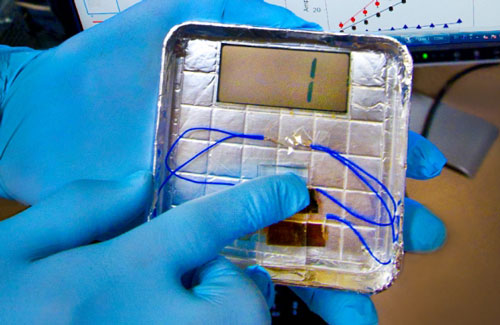| Jul 25, 2013 |
Piezoelectric strength of viruses powers battery
|
|
(Nanowerk News) Berkeley Lab scientists Byung Yang Lee, Seung-Wuk Lee and Ramamoorthy Ramesh have developed a virus battery of sorts -- one powered by motion ("Virus-based piezoelectric energy generation").
|
|
The device developed by the Berkeley Lab team is the first to produce electricity by using the piezoelectric properties of a biological material. Piezoelectricity is the accumulation of a charge in a solid in response to mechanical force -- think cigarette lighters or gas grill starters. In this case, the viruses convert the mechanical energy into electricity.
|
 |
| By applying pressure to the generator, one is able to generate about six nanoamperes of current and 400 millivolts of potential -- roughly a quarter of the voltage of a AAA battery and enough to flash a number on the small LCD screen. (Photo courtesy of Seung-Wuk Lee's lab at Lawrence Berkeley National Laboratory)
|
|
The M13 bacteriophage, a virus that only infects bacteria and is benign to people, was chosen because it replicates in large numbers quickly, is easy to genetically engineer and large numbers of the virus naturally orient themselves into well-ordered films.
|
|
To increase its effectiveness, the scientists had to increase the piezoelectric strength of the virus. They accomplished this first by genetically engineering the virus to boost its voltage and then by stacking 20 single layers of the virus film on top of one another -- the number they found to exhibit the strongest piezoelectric effect.
|
|
The scientists then decided to test their approach by fabricating a small piezoelectric energy generator.
|
|
First, they created the conditions for the genetically engineered viruses to spontaneously organize into a multilayered film that measures one square centimeter. Then, the film was placed between two gold plated electrodes, which were connected by wires to a small liquid crystal display (LCD). By applying pressure to the generator, one is able to generate about six nanoamperes of current and 400 millivolts of potential -- roughly a quarter of the voltage of a AAA battery and enough to flash a number on the small LCD screen.
|
|
Because traditional piezoelectric materials are often toxic and difficult to work with, virus-based piezoelectric materials present an environmentally friendly approach to piezoelectric energy generation. If brought to scale, viral power generators could be utilized in small electronic gadgets -- like cell phones or music players.
|
|
The commercial potential of this technology was one of the reasons why it recently received an R&D 100 award from R&D Magazine, joining 35 other award winners from the Energy Department's National Labs and facilities.
|

